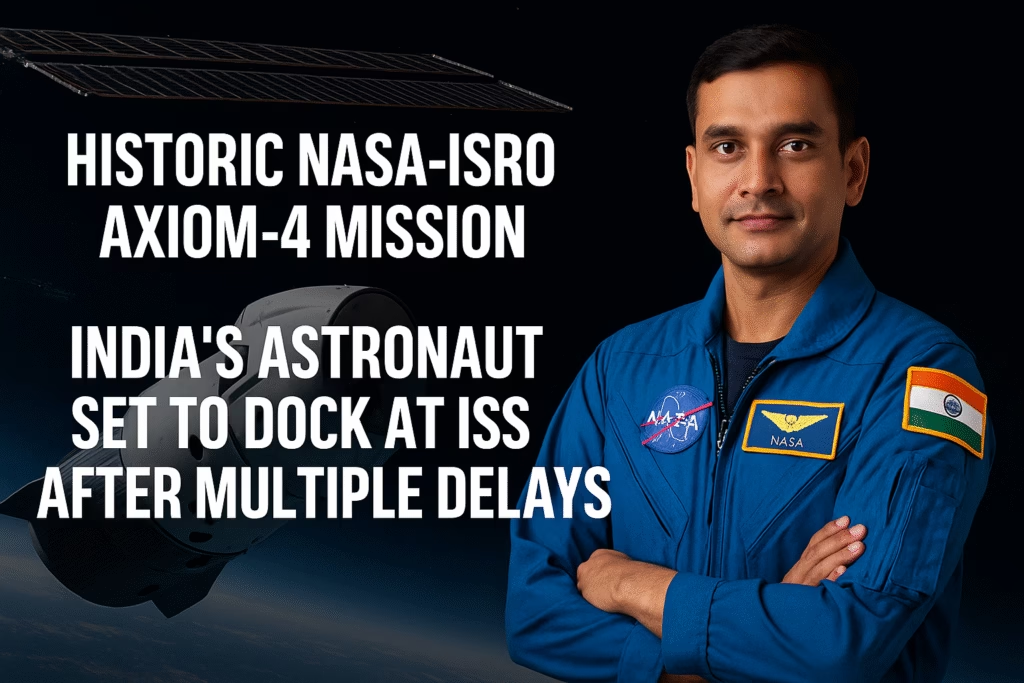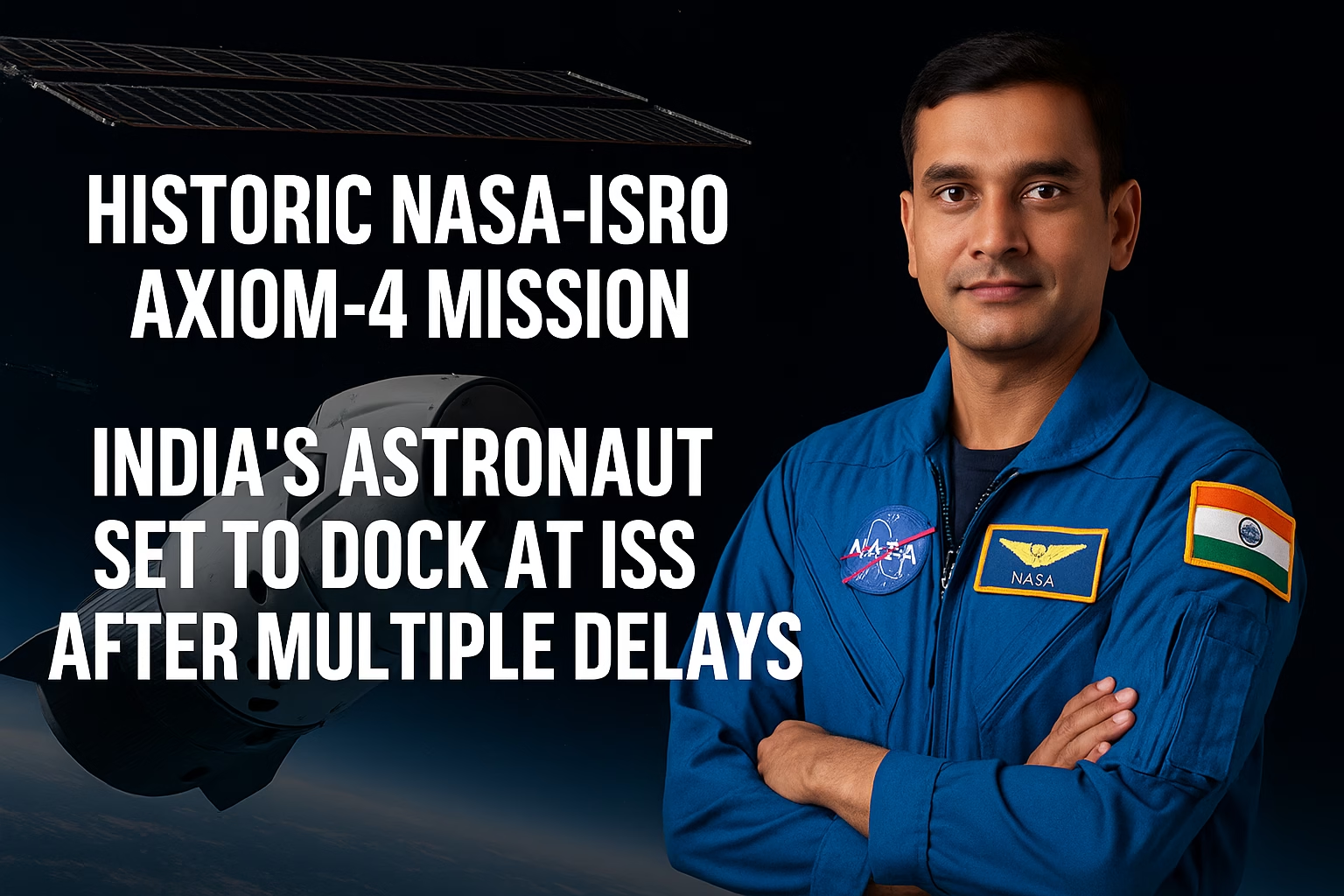By Mumbainews24 | Updated: June 22, 2025
India’s Gaganyaan pilot Group Captain Shubhanshu Shukla to join NASA‑ISRO Axiom‑4 mission after several delays—as private Dragon launch eyes June 2025.
Introduction
India is witnessing a proud and historic moment. After decades of determination and growth in space research, one of our own—Group Captain Shubhanshu Shukla—is ready to take the big leap into space as part of the Axiom‑4 mission, a collaborative effort between NASA, ISRO, Axiom Space, and SpaceX.
The mission, bound for the International Space Station (ISS), is more than just a trip into orbit. It is a strong symbol of India’s emerging leadership in space science and global cooperation. This mission comes at a time when ISRO is preparing for its first-ever independent manned mission, Gaganyaan. Until then, Shubhanshu’s participation in this global mission is already creating waves of excitement across India.
Let’s dive into what makes this mission special, why it was delayed, who is going, and what it means for India’s space future.
Who Is Shubhanshu Shukla?
Group Captain Shubhanshu Shukla is not just any pilot. He is an elite officer of the Indian Air Force, a test pilot by profession, and one of the astronauts being trained under the Gaganyaan human spaceflight program.
Born and raised in India, Shubhanshu’s selection into this mission is a proud moment for every Indian. It’s been over 40 years since Rakesh Sharma became the first Indian in space. Now, Shubhanshu will be the second Indian to fly on an international mission that involves the ISS, and the first Indian to fly aboard a private commercial spacecraft.
He has undergone years of rigorous training in Russia and India, and this mission will be a major stepping stone for his space career.

What Is the Axiom‑4 Mission?
The Axiom‑4 mission is the fourth in a series of private crewed missions to the ISS, operated by Axiom Space, an American private aerospace company. Axiom has partnered with NASA, SpaceX, and now ISRO, to build a bridge between government space agencies and the future of commercial space travel.
The spacecraft taking the crew to the ISS is SpaceX’s Crew Dragon, launched on a Falcon 9 rocket from the Kennedy Space Center in Florida, USA.
This mission is part of the long-term plan to eventually build a commercial space station that could take over ISS operations when it retires in the coming years. Until then, Axiom missions allow astronauts from different countries to experience life and work aboard the ISS.
Why Has the Mission Been Delayed So Many Times?
Originally scheduled for late May 2025, the Axiom‑4 mission has faced multiple delays, frustrating fans and space followers around the globe.
Here are the main reasons for the delays:
- Fuel Leak Issues: A minor leak of liquid oxygen was detected during a static fire test of the Falcon 9 rocket. NASA and SpaceX halted the launch to ensure there were no safety risks.
- Technical Checks at ISS: The Russian-built Zvezda module onboard the ISS had a small leak in its service module. Safety checks were necessary before allowing new astronauts to dock.
- Weather Concerns: Some rescheduled launch windows faced poor weather, making the liftoff unsafe.
- Safety Verifications: Since this mission involves a multinational crew and multiple science experiments, NASA demanded extra checks for crew readiness and equipment compatibility.
Now, although June 22 was eyed as a new possible launch date, it has been put on standby again. NASA will announce a revised schedule shortly.
Meet the Full Axiom‑4 Mission Crew
Here’s a quick look at the four astronauts going on the Axiom‑4 mission:
- Peggy Whitson (Commander) – A legendary name in space science, Peggy holds the record for the most days in space by any American astronaut. She now leads Axiom’s human spaceflight division.
- Shubhanshu Shukla (Pilot) – Representing India, Shubhanshu will assist in spacecraft navigation, scientific operations, and coordination between modules.
- Sławosz Uznański-Wiśniewski (Mission Specialist) – A highly qualified Polish engineer, contributing to medical and physics experiments.
- Tibor Kapu (Mission Specialist) – From Hungary, Tibor will help conduct chemical and environmental research in microgravity.
What Will They Do in Space?
The Axiom‑4 crew will spend 14 to 21 days aboard the ISS. During their stay, they’ll conduct over 60 experiments, covering a wide range of scientific areas:
- Biological Research: Studying how algae and human muscle tissues react in space conditions.
- Agricultural Studies: Observing how crops grow in microgravity, which can help with future farming on Mars or the Moon.
- Materials Testing: Exploring how metals and polymers behave in zero-gravity.
- Indian Experiments: Several Indian research groups are participating in this mission. It’s a proud moment for Indian academia as their experiments reach space for the first time.
Why This Is a Big Deal for India
This is not just a flight. It is India’s return to the manned spaceflight story, something we have been preparing for since Rakesh Sharma’s mission in 1984.
Here’s why it matters so much:
- Confidence Booster: Shubhanshu’s participation helps ISRO test and improve astronaut training for Gaganyaan, which is planned for 2027.
- Global Exposure: Working alongside NASA, SpaceX, and Axiom gives ISRO valuable experience in mission coordination, technology exchange, and international crew handling.
- India’s Global Image: The mission showcases Indian talent on a global stage. It proves that Indian pilots and scientists are capable of meeting international spaceflight standards.
- Inspiration for Youth: Just like how Rakesh Sharma inspired generations, this mission will ignite curiosity among millions of young Indians who dream of becoming astronauts, scientists, and innovators.
What’s Next for ISRO?
While Axiom‑4 is in the global spotlight, ISRO is quietly and strongly working on its own future:
- Gaganyaan: India’s first independent manned mission is progressing with robotic module testing and launch simulations.
- Chandrayaan-4: A follow-up moon mission is under development, likely to bring back lunar samples.
- Space Station Vision: ISRO aims to develop its own mini space station in the next 10–12 years, with the Gaganyaan crew being the first candidates to visit.
Final Thoughts
The Axiom‑4 mission is more than a scientific journey — it’s a symbol of collaboration, progress, and the human desire to explore the unknown. For India, it’s a stepping stone that will open the gates to more opportunities in the space industry.
Whether the mission launches this week or next, the countdown has already started in the hearts of millions of Indians. We salute Group Captain Shubhanshu Shukla and all those working behind the scenes to make this mission a success.
India is reaching for the stars — and this time, we’re not just watching; we’re going with them.
Stay informed—and take advantage of this window while it lasts.



